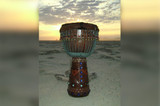Keep the Beat Alive with Claves
Claves are a type of rhythm or percussion sticks. Playing the claves means two, short pieces of wood are clanked together in rhythm. The use of the instrument is said to have originated thousands of years ago, as it has been used in rituals and music since ancient times. Modern use of claves seems to have gained popularity with Afro-Cuban folk music and the Latin music culture has yet to relinquish its grasp of this fine instrument. In fact, the name clave means “key” or “keystone” in Spanish, which foretells of their significance.
These days, claves are mostly used in African, Cuban, and Brazilian music, as well as Latin American dance bands. In Cuban music, claves provide such a foundation that a basic rhythm pattern is actually called clave and it is a key or guide pattern for the musicians. This clave rhythm consists of a five-note pattern in which three notes are followed by two for the forward rhythm and two notes are followed by three for the reverse clave rhythm.
Claves are normally made from rosewood, ebony, or grenadilla, an African wood that is also used for clarinets and other woodwind instruments and gained popularity when the Portuguese were looking for ebony alternatives many centuries ago. Rosewood is a strong, hard wood that is suitable for use with things that face harsh use conditions, such as flooring and claves. True rosewood is best known as Brazilian Rosewood and emits a strong, sweet smell throughout the years, hence the name. It is currently an endangered species. The other popular, classic rosewood is commonly called Indian Rosewood and it is found in Madagascar, tropical America, and Southeast Asia.
Modern claves may be made from the traditional materials or from fiberglass and plastic. The most important factors with claves are their resistance and resonance. Fiberglass and plastic have great durability and possibly lower cost for the musician, making them an attractive option for some. Some claves are hollow or carved in the middle in order to amplify their sound. There are typically two ways to play the claves: hold one and hit it with the other or hold them parallel to each other and bang them together. The most common way is to lightly hold one clave in the less dominant hand, supporting it with the thumb and fingertips. Then, the dominant hand is used to firmly hold the end of the other clave, striking the middle of the first.
In the USA, most schoolchildren are exposed to claves and then we might not see them, again, unless we find ourselves interested in music from other parts of the world. Claves, however, are a wonderful instrument to keep on-hand at all times. Easy to carry, easy to use, and fun to play, claves can add the wonderful depth and dimension percussion instruments are known for to any musical situation. And, if one is lucky enough, there might also be a sweet smell to accompany that beautiful sound.
Recent Posts
-
What is the Best Size Djembe for Beginners?
If you're new to the world of percussion and interested in learning the djembe, you're in for a t …16th Jul 2024 -
The Benefits of Becoming a Drumming Teacher: Transforming Passion into Profession
Why become a drumming teacher? Becoming a drumming teacher is an excellent way to share your pas …22nd May 2024 -
What Makes the Djembe Drum a Spiritual Instrument in African Music?
Origin and history of the Djembe drum The Djembe drum originates from West Africa and holds sign …16th May 2024




